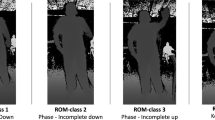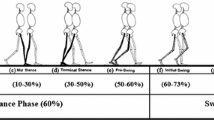Abstract
Electromyography (EMG) pattern recognition has been widely employed for prosthesis control. Several studies demonstrated that amputees had poorer performances of EMG pattern recognition when compared to able-bodied individuals. Several factors, such as the muscle weakness and atrophy of residual limbs, the length of residual limbs, and the decrease of the affected side's motor cortex, had been studied to improve the performance of amputees. However, there was no study on the factor that the absence of joint movements for amputees. This study aimed to investigate whether the hand and wrist joint movements had effects on the EMG pattern recognition. Ten able-bodied subjects were tested for 11 hand and wrist gestures with two different gesture modalities: hand and wrist joints unconstrained (HAWJU) and constrained (HAWJC). Time-domain (TD) features and Linear Discriminant Analysis (LDA) were employed to compare the classification performance of the two modalities. Compared to HAWJU, HAWJC significantly reduced the average Classification Accuracy (CA) across all subjects from 95.53 to 85.52%. The experimental results demonstrated that the hand and wrist joint movements had significant effects on EMG pattern recognition. The outcomes provided a new perspective to study the factors affecting EMG pattern recognition.








Similar content being viewed by others
References
Zhang, X., Wu, L., Yu, B., Chen, X., & Chen, X. (2020). Adaptive calibration of electrode array shifts enables robust myoelectric control. IEEE Transactions on Biomedical Engineering, 67, 1947–1957.
Wu, L., Zhang, X., Wang, K., Chen, X., & Chen, X. (2020). Improved high-density myoelectric pattern recognition control against electrode shift using data augmentation and dilated convolutional neural network. IEEE Transactions on Neural Systems and Rehabilitation Engineering, 28, 2637–2646.
Fang, Y. F., Zhou, D. L., Li, K. R., & Liu, H. H. (2017). Interface prostheses with classifier-feedback-based user training. IEEE Transactions on Biomedical Engineering, 64, 2575–2583.
Menon, R., Di Caterina, G., Lakany, H., Petropoulakis, L., Conway, B. A., & Soraghan, J. J. (2017). Study on interaction between temporal and spatial information in classification of EMG signals for myoelectric prostheses. IEEE Transactions on Neural Systems and Rehabilitation Engineering, 25, 1832–1842.
Asogbon, M. G., Samuel, O. W., Geng, Y. J., Oluwagbemi, O., Ning, J., Chen, S. X., Ganesh, N., Feng, P., & Li, G. L. (2020). Towards resolving the co-existing impacts of multiple dynamic factors on the performance of EMG-pattern recognition based prostheses. Computer Methods and Programs in Biomedicine, 184, 105278.
He, Y., Fukuda, O., Bu, N., Okumura, H., & Yamaguchi, N. (2018). Surface EMG pattern recognition using long short-term memory combined with multilayer perceptron. In: Annual International Conference of the IEEE Engineering in Medicine and Biology Society (EMBC), Honolulu, HI, USA, 2018, pp 5636–5639.
Pan, L. Z., Zhang, D. G., Sheng, X. J., & Zhu, X. Y. (2015). Improving myoelectric control for amputees through transcranial direct current stimulation. IEEE Transactions on Biomedical Engineering, 62, 1927–1936.
Atzori, M., Gijsberts, A., Castellini, C., Caputo, B., Hager, A. G. M., Elsig, S., Giatsidis, G., Bassetto, F., & Muller, H. (2016). Effect of clinical parameters on the control of myoelectric robotic prosthetic hands. Journal of Rehabilitation Research and Development, 53, 345–358.
Jiang, N., Muceli, S., Graimann, B., & Farina, D. (2013). Effect of arm position on the prediction of kinematics from EMG in amputees. Medical & Biological Engineering & Computing, 51, 143–151.
Taghizadeh, Z., Rashidi, S., & Shalbaf, A. (2021). Finger movements classification based on fractional fourier transform coefficients extracted from surface EMG signals. Biomedical Signal Processing and Control, 68, 102573.
Cipriani, C., Antfolk, C., Controzzi, M., Lundborg, G., Rosen, B., Carrozza, M. C., & Sebelius, F. (2011). Online myoelectric control of a dexterous hand prosthesis by transradial amputees. IEEE Transactions on Neural Systems and Rehabilitation Engineering, 19, 260–270.
Powell, M. A., Kaliki, R. R., & Thakor, N. V. (2014). User training for pattern recognition-based myoelectric prostheses: Improving phantom limb movement consistency and distinguishability. IEEE Transactions on Neural Systems and Rehabilitation Engineering, 22, 522–532.
Waris, A., Niazi, I. K., Jamil, M., Gilani, O., Englehart, K., Jensen, W., Shafique, M., & Kamavuako, E. N. (2018). The effect of time on EMG classification of hand motions in able-bodied and transradial amputees. Journal of Electromyography and Kinesiology, 40, 72–80.
Kilteni, K., Grau-Sanchez, J., Veciana De Las Heras, M., Rodriguez-Fornells, A., & Slater, M. (2016). Decreased corticospinal excitability after the illusion of missing part of the arm. Frontiers in Human Neuroscience, 10, 145.
Lunnen, J. D., Yack, J., & LeVeau, B. F. (1981). Relationship between muscle length, muscle activity, and torque of the hamstring muscles. Physical Therapy, 61, 190–195.
Centomo, H., Amarantini, D., Martin, L., & Prince, F. (2008). Differences in the coordination of agonist and antagonist muscle groups in below-knee amputee and able-bodied children during dynamic exercise. Journal of Electromyography and Kinesiology, 18, 487–494.
Clites, T. R., Herr, H. M., Srinivasan, S. S., Zorzos, A. N., & Carty, M. J. (2018). The ewing amputation: the first human implementation of the agonist-antagonist myoneural interface. Plastic and Reconstructive Surgery-Global Open, 6, e1997.
Martin, S., & MacIsaac, D. (2006). Innervation zone shift with changes in joint angle in the brachial biceps. Journal of Electromyography and Kinesiology, 16, 144–148.
Malesevic, N., Bjorkman, A., Andersson, G. S., Matran-Fernandez, A., Citi, L., Cipriani, C., & Antfolk, C. (2020). A database of multi-channel intramuscular electromyogram signals during isometric hand muscles contractions. Scientific Data, 7, 1–12.
Li, G. L., & Kuiken, T. A. (2009). EMG pattern recognition control of multifunctional prostheses by transradial amputees. In: Annual International Conference of the IEEE Engineering in Medicine and Biology Society (EMBC), Minneapolis, MN, USA, 2009, pp 6914–6917.
Khushaba, R. N., Al-Timemy, A., Kodagoda, S., & Nazarpour, K. (2016). Combined influence of forearm orientation and muscular contraction on EMG pattern recognition. Expert Systems with Applications, 61, 154–161.
Gupta, R., & Agarwal, R. (2019). Single channel EMG-based continuous terrain identification with simple classifier for lower limb prosthesis. Biocybernetics and Biomedical Engineering, 39, 775–788.
Yang, K., & Zhang Z. (2019). Real-time pattern recognition for hand gesture based on ANN and surface EMG. In: IEEE 8th Joint International Information Technology and Artificial Intelligence Conference (ITAIC), Chongqing, China, 2019, pp 799–802.
Hudgins, B., Parker, P., & Scott, R. N. (1993). A new strategy for multifunction myoelectric control. IEEE Transactions on Biomedical Engineering, 40, 82–94.
Pan, L. Z., Zhang, D. G., Liu, J. W., Sheng, X. J., & Zhu, X. Y. (2014). Continuous estimation of finger joint angles under different static wrist motions from surface EMG signals. Biomedical Signal Processing and Control, 14, 265–271.
Hakonen, M., Piitulainen, H., & Visala, A. (2015). Current state of digital signal processing in myoelectric interfaces and related applications. Biomedical Signal Processing and Control, 18, 334–359.
Sheng, X. J., Lv, B., Guo, W. C., & Zhu, X. Y. (2019). Common spatial-spectral analysis of EMG signals for multiday and multiuser myoelectric interface. Biomedical Signal Processing and Control, 53, 101572.
Bellingegni, A. D., Gruppioni, E., Colazzo, G., Davalli, A., Sacchetti, R., Guglielmelli, E., & Zollo, L. (2017). NLR, MLP, SVM, and LDA: A comparative analysis on EMG data from people with trans-radial amputation. Journal of Neuroengineering and Rehabilitation, 14, 1–16.
Lucas, M. F., Gaufriau, A., Pascual, S., Doncarli, C., & Farina, D. (2008). Multi-channel surface EMG classification using support vector machines and signal-based wavelet optimization. Biomedical Signal Processing and Control, 3, 169–174.
Oskoei, M. A., & Hu, H. S. (2008). Support vector machine-based classification scheme for myoelectric control applied to upper limb. IEEE Transactions on Biomedical Engineering, 55, 1956–1965.
Wang, J. H., Ren, H. C., Chen, W. H., Zhang, P. (2015). A portable artificial robotic hand controlled by EMG signal using ANN classifier. In: IEEE International Conference on Information and Automation (ICIA), Lijiang, China, 2015, pp 2709–2714.
Gallant, P. J., Morin, E. L., & Peppard, L. E. (1998). Feature-based classification of myoelectric signals using artificial neural networks. Medical & Biological Engineering & Computing, 36, 485–489.
Kim, K. S., Choi, H. H., Moon, C. S., & Mun, C. W. (2011). Comparison of k-nearest neighbor, quadratic discriminant and linear discriminant analysis in classification of electromyogram signals based on the wrist-motion directions. Current Applied Physics, 11, 740–745.
Phinyomark, A., Quaine, F., Charbonnier, S., Serviere, C., Tarpin-Bernard, F., & Laurillau, Y. (2013). EMG feature evaluation for improving myoelectric pattern recognition robustness. Expert Systems with Applications, 40, 4832–4840.
Narayan, Y. (2021). Hb vsEMG signal classification with time domain and Frequency domain features using LDA and ANN classifier. Materials Today: Proceedings, 37, 3226–3230.
Bunderson, N. E., & Kuiken, T. A. (2012). Quantification of feature space changes with experience during electromyogram pattern recognition control. IEEE Transactions on Neural Systems and Rehabilitation Engineering, 20, 239–246.
Rabin, N., Kahlon, M., Malayev, S., & Ratnovsky, A. (2020). Classification of human hand movements based on EMG signals using nonlinear dimensionality reduction and data fusion techniques. Expert Systems with Applications, 149, 113281.
Tsai, A. C., Hsieh, T. H., Luh, J. J., & Lin, T. T. (2014). A comparison of upper-limb motion pattern recognition using EMG signals during dynamic and isometric muscle contractions. Biomedical Signal Processing and Control, 11, 17–26.
Srinivasan, S. S., Tuckute, G., Zou, J., Gutierrez-Arango, S., Song, H., Barry, R. L., & Herr, H. M. (2020). Agonist-antagonist myoneural interface amputation preserves proprioceptive sensorimotor neurophysiology in lower limbs. Science Translational Medicine, 12, eabc5926.
Acknowledgements
The authors thank all volunteers who participated in the study. This work was supported in part by the National Natural Science Foundation of China (Grant No. 52005364, 52122501) and the State Key Laboratory of Mechanical System and Vibration (Grant No. MSV202012). This work was also supported by the Key Laboratory of Mechanism Theory and Equipment Design of the Ministry of Education (Tianjin University).
Author information
Authors and Affiliations
Corresponding author
Ethics declarations
Conflict of Interest
The authors declare that they have no conflict of interest.
Additional information
Publisher's Note
Springer Nature remains neutral with regard to jurisdictional claims in published maps and institutional affiliations.
Rights and permissions
About this article
Cite this article
Pan, L., Liu, K., Zhu, K. et al. Comparing EMG Pattern Recognition with and Without Hand and Wrist Movements. J Bionic Eng 19, 700–708 (2022). https://doi.org/10.1007/s42235-022-00171-7
Received:
Revised:
Accepted:
Published:
Issue Date:
DOI: https://doi.org/10.1007/s42235-022-00171-7




